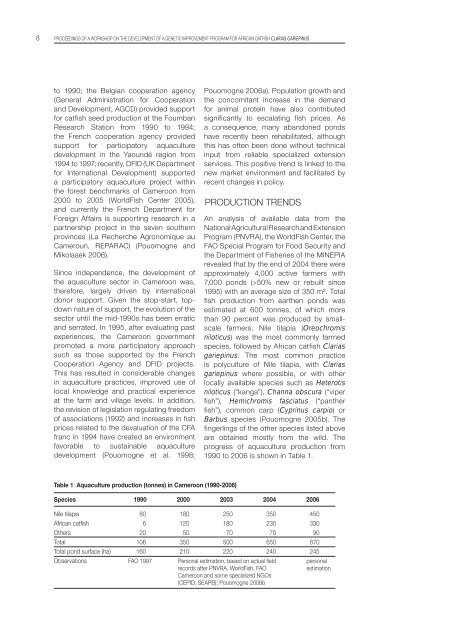COUNTRY CASE STUDY: CATFISH INDUSTRY IN CAMEROON 7Since 1985, research activities relatedto freshwater aquaculture have beenc<strong>on</strong>ducted at <strong>the</strong> Foumban <strong>Fish</strong> Culture and<strong>Fish</strong>eries Research Stati<strong>on</strong>. Most activitiesare oriented toward optimizing <strong>the</strong> artificialpropagati<strong>on</strong> <str<strong>on</strong>g>of</str<strong>on</strong>g> <strong>the</strong> main cultured catfish(Clarias gariepinus and Heterobranchusl<strong>on</strong>gifilis), as well as domesticating newcatfish species suitable for aquaculture.There is a general lack <str<strong>on</strong>g>of</str<strong>on</strong>g> knowledge <strong>on</strong> <strong>the</strong>genetic variability <str<strong>on</strong>g>of</str<strong>on</strong>g> <strong>the</strong> different strains <str<strong>on</strong>g>of</str<strong>on</strong>g>C. gariepinus farmed in different parts <str<strong>on</strong>g>of</str<strong>on</strong>g>Camero<strong>on</strong>, this species being alien to <strong>the</strong>river basins in which it is cultured. Data <strong>on</strong><strong>the</strong> reproductive biology and feeding habits<str<strong>on</strong>g>of</str<strong>on</strong>g> catfish species in <strong>the</strong> wild are also lacking.The policy envir<strong>on</strong>ment is now supportiveand Camero<strong>on</strong> will become an importantaquaculture producer in <strong>the</strong> near future.INTRODUCTIONThe aquaculture industry in Camero<strong>on</strong>is essentially rural and its objectives areto increase fish supplies and providesupplementary and alternative employment,generate income, and improve <strong>the</strong> nutriti<strong>on</strong><str<strong>on</strong>g>of</str<strong>on</strong>g> subsistence farmers (Satia et al.1988). However, fifty-nine years after <strong>the</strong>introducti<strong>on</strong> <str<strong>on</strong>g>of</str<strong>on</strong>g> aquaculture in <strong>the</strong> country,it has failed to improve rural nutriti<strong>on</strong>al andincome standards. Its c<strong>on</strong>tributi<strong>on</strong> to nati<strong>on</strong>alfishery producti<strong>on</strong> remains insignificant.Camero<strong>on</strong>, although self-sufficient in mostdomains <str<strong>on</strong>g>of</str<strong>on</strong>g> agro-food, has defaulted <strong>on</strong> itsprovisi<strong>on</strong> <str<strong>on</strong>g>of</str<strong>on</strong>g> fish products. <strong>Fish</strong> c<strong>on</strong>tinuesto be <strong>the</strong> main source <str<strong>on</strong>g>of</str<strong>on</strong>g> protein for <strong>the</strong>Camero<strong>on</strong>ian populati<strong>on</strong>s, especially for <strong>the</strong>most underprivileged layers (Nguenga andPouomogne 2006). The nati<strong>on</strong>al producti<strong>on</strong>is essentially assured by <strong>the</strong> country’smaritime, artisanal and industrial fishingand by c<strong>on</strong>tinental fishing. The nati<strong>on</strong>alneeds increase annually in proporti<strong>on</strong> with<strong>the</strong> populati<strong>on</strong> growth. The gap betweendemand and supply obliges Camero<strong>on</strong> toimport c<strong>on</strong>siderable quantities <str<strong>on</strong>g>of</str<strong>on</strong>g> frozenfish.In 2005, nearly 49 percent <str<strong>on</strong>g>of</str<strong>on</strong>g> animal proteinc<strong>on</strong>sumed in Camero<strong>on</strong>, 17 kg per pers<strong>on</strong>annually, c<strong>on</strong>sisted <str<strong>on</strong>g>of</str<strong>on</strong>g> fish (Brummett 2007).Demand is high and c<strong>on</strong>tinues to rise withimports passing 53,000 t<strong>on</strong>nes in 1997,63,000 t<strong>on</strong>nes in 1998, and 78,000 t<strong>on</strong>nes in1999. In 2002, Camero<strong>on</strong> imported 182,000t<strong>on</strong>nes <str<strong>on</strong>g>of</str<strong>on</strong>g> fish, representing 52 percent <str<strong>on</strong>g>of</str<strong>on</strong>g>domestic supplies, at a total cost <str<strong>on</strong>g>of</str<strong>on</strong>g> nearlyUS$90 milli<strong>on</strong> (FAOSTAT 2004). <strong>Fish</strong> pricesremain stubbornly high at around US$3.50per kg live weight <strong>on</strong> <strong>the</strong> wholesale market.Through a series <str<strong>on</strong>g>of</str<strong>on</strong>g> c<strong>on</strong>sultati<strong>on</strong>s facilitatedby FAO (April 2003 and December 2004) and<strong>the</strong> <strong>World</strong><strong>Fish</strong> <strong>Center</strong> (April and November2004), access to markets, availability <str<strong>on</strong>g>of</str<strong>on</strong>g>high quality technical backstopping andregular supply <str<strong>on</strong>g>of</str<strong>on</strong>g> fish fingerlings have beenrepeatedly identified as key c<strong>on</strong>straintsto aquaculture growth. According to <strong>the</strong>government, if <strong>the</strong>se can be overcome,Camero<strong>on</strong> has <strong>the</strong> biophysical potential(i.e. land, water and feed materials) to easilyproduce 20,000 t<strong>on</strong>nes <str<strong>on</strong>g>of</str<strong>on</strong>g> fish per annumthrough aquaculture, and increase <strong>the</strong>current producti<strong>on</strong> by more than a factor <str<strong>on</strong>g>of</str<strong>on</strong>g>twenty.OVERVIEW OF THENATIONAL AQUACULTURESECTORHISTORICAL BACKGROUND<strong>Fish</strong> farming started in Camero<strong>on</strong> in 1948,and in 1952 <strong>the</strong> col<strong>on</strong>ial administrati<strong>on</strong>(England in <strong>the</strong> West adjacent to Nigeria,and France in <strong>the</strong> Eastern Camero<strong>on</strong>) built22 aquaculture dem<strong>on</strong>strati<strong>on</strong> stati<strong>on</strong>s tostreng<strong>the</strong>n <strong>the</strong> fisheries sector. By 1960,<strong>the</strong> number <str<strong>on</strong>g>of</str<strong>on</strong>g> private ear<strong>the</strong>n fishp<strong>on</strong>dsexceeded 10,000. So<strong>on</strong> after independencein 1960, <strong>the</strong> extensi<strong>on</strong> effort collapsed, andmost p<strong>on</strong>ds were aband<strong>on</strong>ed. During <strong>the</strong>early 1970s a UNDP/FAO regi<strong>on</strong>al projectincreased <strong>the</strong> number <str<strong>on</strong>g>of</str<strong>on</strong>g> public aquaculturestati<strong>on</strong>s to 32. However, declining d<strong>on</strong>orsupport and <strong>the</strong> transfer <str<strong>on</strong>g>of</str<strong>on</strong>g> aquaculture from<strong>the</strong> Forestry Department to <strong>the</strong> LivestockDepartment weakened <strong>the</strong> enthusiasm.From 1980, <strong>the</strong>re was a revival in focussedd<strong>on</strong>or support for aquaculture. The USAIDdeveloped comm<strong>on</strong> carp farming in <strong>the</strong>Western Highlands (1980-84), and PeaceCorps Volunteers assisted until 1998; <strong>the</strong>IDRC provided support for integrated fishcum-pig-and-chickenfarming from 1986
8 PROCEEDINGS OF A WORKSHOP ON THE DEVELOPMENT OF A GENETIC IMPROVEMENT PROGRAM FOR AFRICAN CATFISH CLARIAS GARIEPINUSto 1990; <strong>the</strong> Belgian cooperati<strong>on</strong> agency(General Administrati<strong>on</strong> for Cooperati<strong>on</strong>and <strong>Development</strong>, AGCD) provided supportfor catfish seed producti<strong>on</strong> at <strong>the</strong> FoumbanResearch Stati<strong>on</strong> from 1990 to 1994;<strong>the</strong> French cooperati<strong>on</strong> agency providedsupport for participatory aquaculturedevelopment in <strong>the</strong> Yaoundé regi<strong>on</strong> from1994 to 1997; recently, DFID (UK Departmentfor Internati<strong>on</strong>al <strong>Development</strong>) supporteda participatory aquaculture project within<strong>the</strong> forest benchmarks <str<strong>on</strong>g>of</str<strong>on</strong>g> Camero<strong>on</strong> from2000 to 2005 (<strong>World</strong><strong>Fish</strong> <strong>Center</strong> 2005),and currently <strong>the</strong> French Department forForeign Affairs is supporting research in apartnership project in <strong>the</strong> seven sou<strong>the</strong>rnprovinces (La Recherche Agr<strong>on</strong>omique auCameroun, REPARAC) (Pouomogne andMikolasek 2006).Since independence, <strong>the</strong> development <str<strong>on</strong>g>of</str<strong>on</strong>g><strong>the</strong> aquaculture sector in Camero<strong>on</strong> was,<strong>the</strong>refore, largely driven by internati<strong>on</strong>ald<strong>on</strong>or support. Given <strong>the</strong> stop-start, topdownnature <str<strong>on</strong>g>of</str<strong>on</strong>g> support, <strong>the</strong> evoluti<strong>on</strong> <str<strong>on</strong>g>of</str<strong>on</strong>g> <strong>the</strong>sector until <strong>the</strong> mid-1990s has been erraticand serrated. In 1995, after evaluating pastexperiences, <strong>the</strong> Camero<strong>on</strong> governmentpromoted a more participatory approachsuch as those supported by <strong>the</strong> FrenchCooperati<strong>on</strong> Agency and DFID projects.This has resulted in c<strong>on</strong>siderable changesin aquaculture practices, improved use <str<strong>on</strong>g>of</str<strong>on</strong>g>local knowledge and practical experienceat <strong>the</strong> farm and village levels. In additi<strong>on</strong>,<strong>the</strong> revisi<strong>on</strong> <str<strong>on</strong>g>of</str<strong>on</strong>g> legislati<strong>on</strong> regulating freedom<str<strong>on</strong>g>of</str<strong>on</strong>g> associati<strong>on</strong>s (1992) and increases in fishprices related to <strong>the</strong> devaluati<strong>on</strong> <str<strong>on</strong>g>of</str<strong>on</strong>g> <strong>the</strong> CFAfranc in 1994 have created an envir<strong>on</strong>mentfavorable to sustainable aquaculturedevelopment (Pouomogne et al. 1998;Pouomogne 2006a). Populati<strong>on</strong> growth and<strong>the</strong> c<strong>on</strong>comitant increase in <strong>the</strong> demandfor animal protein have also c<strong>on</strong>tributedsignificantly to escalating fish prices. Asa c<strong>on</strong>sequence, many aband<strong>on</strong>ed p<strong>on</strong>dshave recently been rehabilitated, althoughthis has <str<strong>on</strong>g>of</str<strong>on</strong>g>ten been d<strong>on</strong>e without technicalinput from reliable specialized extensi<strong>on</strong>services. This positive trend is linked to <strong>the</strong>new market envir<strong>on</strong>ment and facilitated byrecent changes in policy.PRODUCTION TRENDSAn analysis <str<strong>on</strong>g>of</str<strong>on</strong>g> available data from <strong>the</strong>Nati<strong>on</strong>al Agricultural Research and Extensi<strong>on</strong>Program (PNVRA), <strong>the</strong> <strong>World</strong><strong>Fish</strong> <strong>Center</strong>, <strong>the</strong>FAO Special Program for Food Security and<strong>the</strong> Department <str<strong>on</strong>g>of</str<strong>on</strong>g> <strong>Fish</strong>eries <str<strong>on</strong>g>of</str<strong>on</strong>g> <strong>the</strong> MINEPIArevealed that by <strong>the</strong> end <str<strong>on</strong>g>of</str<strong>on</strong>g> 2004 <strong>the</strong>re wereapproximately 4,000 active farmers with7,000 p<strong>on</strong>ds (>50% new or rebuilt since1995) with an average size <str<strong>on</strong>g>of</str<strong>on</strong>g> 350 m². Totalfish producti<strong>on</strong> from ear<strong>the</strong>n p<strong>on</strong>ds wasestimated at 600 t<strong>on</strong>nes, <str<strong>on</strong>g>of</str<strong>on</strong>g> which morethan 90 percent was produced by smallscalefarmers. Nile tilapia (Oreochromisniloticus) was <strong>the</strong> most comm<strong>on</strong>ly farmedspecies, followed by African catfish Clariasgariepinus. The most comm<strong>on</strong> practiceis polyculture <str<strong>on</strong>g>of</str<strong>on</strong>g> Nile tilapia, with Clariasgariepinus where possible, or with o<strong>the</strong>rlocally available species such as Heterotisniloticus (“kanga”), Channa obscura (“viperfish”), Hemichromis fasciatus (“pan<strong>the</strong>rfish”), comm<strong>on</strong> carp (Cyprinus carpio) orBarbus species (Pouomogne 2005b). Thefingerlings <str<strong>on</strong>g>of</str<strong>on</strong>g> <strong>the</strong> o<strong>the</strong>r species listed aboveare obtained mostly from <strong>the</strong> wild. Theprogress <str<strong>on</strong>g>of</str<strong>on</strong>g> aquaculture producti<strong>on</strong> from1990 to 2006 is shown in Table 1.Table 1: Aquaculture producti<strong>on</strong> (t<strong>on</strong>nes) in Camero<strong>on</strong> (1990-2006)Species 1990 2000 2003 2004 2006Nile tilapia 80 180 250 350 450African catfish 6 120 180 230 330O<strong>the</strong>rs 20 50 70 70 90Total 106 350 500 650 870Total p<strong>on</strong>d surface (ha) 160 210 220 240 245Observati<strong>on</strong>s FAO 1997 Pers<strong>on</strong>al estimati<strong>on</strong>, based <strong>on</strong> actual field pers<strong>on</strong>alrecords after PNVRA, <strong>World</strong><strong>Fish</strong>, FAOestimati<strong>on</strong>Camero<strong>on</strong> and some specialized NGOs(CEPID, SEAPB); Pouomogne 2006b
















